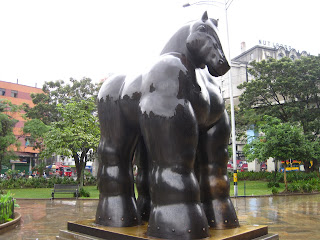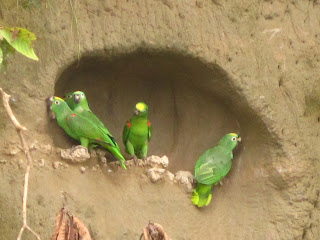- The class is half-full of art history nerds. You can especially tell who is an art history nerd and who is a art history amateur (myself included) when we sit in a cafe after going to a museum. The art history nerds (which I write with much affection) will talk the teacher's ear off about some abstract painting; an art conference coming to town; or problems that are affecting the Ecuadorian art field in general. Really heavy stuff. The rest of us will chat about the new airport in town, the weather, our next vacation, or a new movie. As you can imagine, I'm getting pretty good at Ecuadorian small talk.
- I'm now understanding 80% of what is said, maybe 75% on the day that starts at 9 am. I'm not a morning person when it comes to Spanish - I've found that my Spanish level decreases noticeably when I'm forced to communicate articulately at wee hours of the morning. So trying to identify what kind of art style a painting is before 10 am is not really happening. I sit back and soak it all in until my mind starts up for the day. Next week we have a 4-hour class and I think my head might just implode by the third hour. I've heard talk of pastries making an appearance though.
- Camilo Egas is one of my new favorites. The other week, our teacher took us to the museum of Quito's most under-appreciated artist, Camilo Egas. Let me tell you - this guy painted it all. He painted impressionism, cubism, abstract expressionism, surrealism, Spanish modernism, and lots of indigenous art. I couldn't take photos, but you can check out his work here.
- I have an exam... tomorrow. I should be studying my butt off like all the good art history nerds, but I'm having a hard time concentrating on it tonight. We've got the most amazing cloud show happening outside our window right now. It's good blog-writing weather.
- My next presentation is on Latino artists in New York in the 20th century. My teacher says she's got text (in English!) for me so I think she's taken pity on me. I've also noticed there are not that many Ecuadorian art history books out there. And the ones that are out there are difficult to read. My theory is that these art history experts know they're a select few who write about Ecuadorian art history so they feel inventing obscure words (that aren't in any dictionary and confuse even the native Spanish speakers, mind you) is their right. They exercise that right pretty much every sentence. The sentences in these art history texts are something else, too. I've never seen such long sentences in my life. I've actually started counting the longest sentences I've seen so far - the record is 8 lines (2 lines less than this bullet point).
- I'll finish with some other painters for you to check out. Since our class is about Ecuadorian and Latin American painters, we've studied painters from all over. I've enjoyed Tarsila do Amaral from Brazil; Emilio Pettorutti from Argentina (futurism!); Pedro Figari from Uruguay; and Luis Martinez from Ecuador (I did a presentation on him - beautiful landscapes of Ecuador. I have to write a blog post just about him. After all, I did the research and my class probably only understood half of what I said anyway so other people should benefit from this knowledge).
 |
| This is one of my favorites of Luis Martinez - it's from a book called "Luis A. Martinez" by Fernando Jurado Noboa. |


















